Since the demise of the Soviet Union in 1989, communism has lost a clear sense of purpose, ideologically speaking. But even more importantly, the communist parties and intellectuals all over the world, who were propped and funded by the Comintern, lost the patronage of their communist masters in Moscow. Post 1989 most communist intellectuals turned mercenary, offering their services to the highest bidder.
Their services were readily bought by both the Christian missionary and Islamic organizations. The Church had been funding many such intellectuals for decades. They were joined by the Islamic organizations in the 1990s. The demise of communism coincided with the rise of Islamism. Flushed with petro-dollars and a new found religious zeal, the Islamic organizations started funding universities, news agencies and political parties.
While worldwide, the Christian and Islamic lobbies are at loggerheads, in India they work together against the Hindu majority, united under the anti-Hindu umbrella lobby.
Delhi Press and rampant Hinduphobia
Delhi Press is one of the largest publishing houses that offers 36 magazines in 10 different languages to its readers. Delhi Press was started in 1939 and it started first with its magazine Caravan in 1940. It also offered its flagship Magazine Sarita. Founder Vishwanath’s son, Paresh Nath is now the publisher and Editor-in-Chief of all the magazines under Delhi Press and Ananth Nath, the grandson of the founder who is the Editor of Caravan Magazine.
An interesting observation was made in an opinion piece published in IndiaFacts.org. The author wrote:
Paresh Nath is the editor of a mind-boggling number of 30 magazines of his own group. This is not normal for any big publishing house. This usually occurs when a strict centralized control is needed for maintaining ideological purity.
Delhi Press, under whose ages the Champak is published, has traditionally been far removed from ground realities and has often demonised Hindus and the Indian state in order to further the leftist propaganda, and hence, it is no surprise that children’s digest Champak has too gone that way.
Champak
While radical Islam has gripped the world with millions of brutal deaths being attributed to the violence it unleashes on Kafirs, a cottage industry that mainly focuses on the demonisation of Hindus has thrived for decades, shielding the killers and maligning the victims. The modern-day Goebbels propaganda uses even children for its nefarious means unabashedly. A case in point being one of the latest editions of children’s magazine – Champak.
A Twitter user who goes by the handle @OnlyNakedTruth tweeted some screenshots of Champak’s October edition that focussed on Kashmir and the Modi government’s move to dilute Article 370 thereby suspending the special status that Kashmir enjoyed for decades. One of the screenshots shared by the Twitter handle urged children to write to other children in Kashmir.
Does anyone know why children's magazine Champak has become a leftist-Islamic tool of propaganda? Their Oct edition cover story is about Kashmir (came out after article 370 removal). It is encouraging kids to understand the difficulties faced by KMs there by writing to them. pic.twitter.com/er5msEOR2z
— CBG San (@OnlyNakedTruth) October 23, 2019
The magazine actually says that after the special status of Kashmir was revoked, there was been a strict crackdown in the valley. “Thousands of soldiers and Army battalions have been sent to Kashmir and there is a strict curfew in place. The telephone lines and internet services have also been suspended”, the magazine says.
In the next portions, Champak paints a grim picture of a little boy wanting to play and go to school, while the terrible Indian state and its oppression doesn’t allow him to do so. To top it all, it also talks about how the mother of the boy is not at home and the father is distressed about him not being able to contact her due to the phone lines not working.
While there is no disputing the facts, that there was indeed a crackdown on communication in the valley, Kashmir is a far more nuanced subject that cannot be explained to pre-teens and school children with an anecdote laced with sentimentality. The story obviously doesn’t tell the children about the rampant Jihad in Kashmir, the presence of ISIS and Pakistan sponsored terrorists, the fact that Hindus of the valley were cleansed or even the draconian effects of Article 370 on women’s rights and rights of other factions. Read More
The dangers of indoctrinating children with pure sentimentality, sans facts are several and that is exactly what the Champak seems to be doing.
An opinion piece published in IndiaFacts.org.
At a time when atheism was unpopular even among adults, the children’s magazine, Champak churned out atheist propaganda, mainly aimed at Hinduism.
It was full of stories of how Diwali nights degenerate into gambling fights; how Nava Ratri celebrations are nothing but a platform for hooliganism, always ending in violence. Many stories showed how worshiping idols was superstition and how a worldview dominated by science should replace a culture dominated by religion, the religion always being Hinduism.
A children’s magazine, Champak, does not just avoid Hindu mythology altogether but portrays it as superstitious, one has to wonder about the motivation behind feeding such militant atheism to really young minds.
Saras Salil and Suman Saurabh
When one takes a look at other magazines by Delhi Press—Saras Salil and Suman Saurabh aimed at adolescents, one arrives at the same conclusion. Hinduism and Hindu culture come out as redundant, old-fashioned and superstitious. Of course, no such atheistic disdain is extended towards either Islam or Christianity.
Sarita, the use of the phrase ‘obscurantism’ and its Hinduphobia
Moving to other offerings of Delhi Press, Sarita, their flagship Hindi magazine bears testament to their rampant Hinduphobia. The Delhi Press website itself describes Sarita as a flagship magazine that fights against “religious obscurantism” and “political authoritarianism”.
It is rather interesting that Delhi Press would use the term ‘fighting religious obscurantism’ to describe Sarita. It essentially means restricting knowledge in the hands of an elite few and is considered to be anti-democracy. And then, they couple of it political authoritarianism. Considering their anti-Hindu writing, one can only conclude that Sarita aims to questions the tenets of the Hindu culture and religion, which they have often viewed as ‘superstition’. ‘Obscurantism’ when used to describe a deeply anti-Hindu magazine can only be assumed to mean ‘anti-Brahmanism’ which is a trope that is often used by the Left to deride Hinduism falsely.
There are several titles of write-ups in Sarita that make evident its deep anti-Hindu slant. “Kavadiyas, the bearer of superstitious traditions”, “The Illusions of (Hindu) Pandits”, “A Fearful society under the weight of obscure (Hindu) customs”, “Vaastu, a charade of (Hindu) religion”, “The Evil Spell of Dharma” and “Money-making in the name of GharWapasi” are some of the articles that can be found in the magazine.
Here is what the current homepage of Sarita magazine, subsection ‘Dharm’ (religion) looks like:
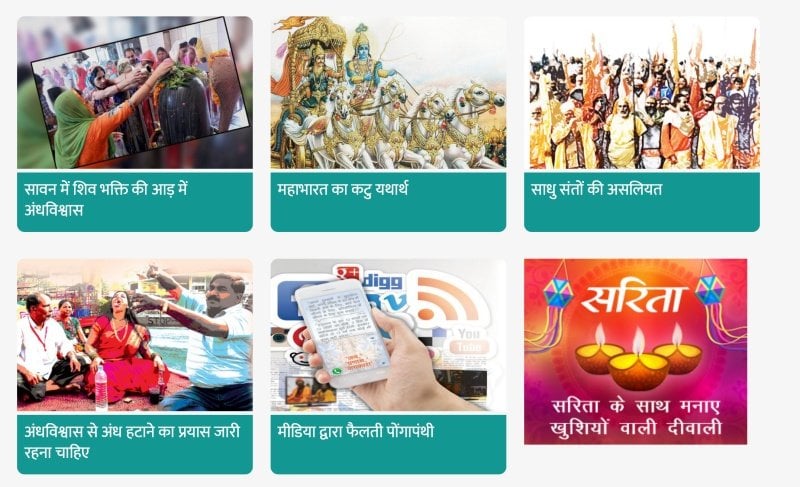
Every single article on the ‘Dharm’ home page derides Hinduism in one way or another barring one out of the 13 articles. From how Pujaris dupe devotees, to how ‘girls are on sale’ in a city of devotion. From claiming to ‘expose’ sadhus and saints to claiming that religion plays with blood. Read More
Even further into their archives, one finds abundant articles that reveal that Sarita is almost on a mission to insult the faith of the Hindus. It is evident that Sarita, Delhi Press’ flagship Hindi magazine has launched a crusade against Hinduism for the past several decades.
Caravan: The original Hinduphobia of Delhi Press
Caravan Magazine was the first offering of the Delhi Press and was launched in 1940. The editors of The Caravan are leftists, specializing in anti-Hinduism. Not just the editors, but the writers that grace the space of the magazine are also anti-Hindus, suffering from acute Hinduphobia. Apart from the editors, some of the most prominent names that write for the magazine are: Ramachandra Guha, Pankaj Mishra, William Dalrymple, Basharat Peer, Praful Bidwai, Girish Karnad, and Ananya Vajpayee. All are well-known Hindu baiters. The current day Caravan is a testament to how low Delhi Press has truly fallen in their quest of malign Hindus.
1. The Pulwama terror attack was a dastardly attack sponsored and orchestrated by Pakistan that claimed the lives of several Indian soldiers. The country mourned in unison. The country demanded vengeance against a terror state that painted the lanes of Pulwama with the blood of our soldiers. While a nation rallied behind the armed forces, Caravan was busy counting caste.
Read: Caravan counting caste of martyrs was not just shoddy journalism, it was to help Jihad. Here is how
2. The Caravan magazine recently posted this where it is claimed that Nalanda was burned by “Hindu Fanatics” and not by Bakhtiyar Khilji, report by Hindu Post.
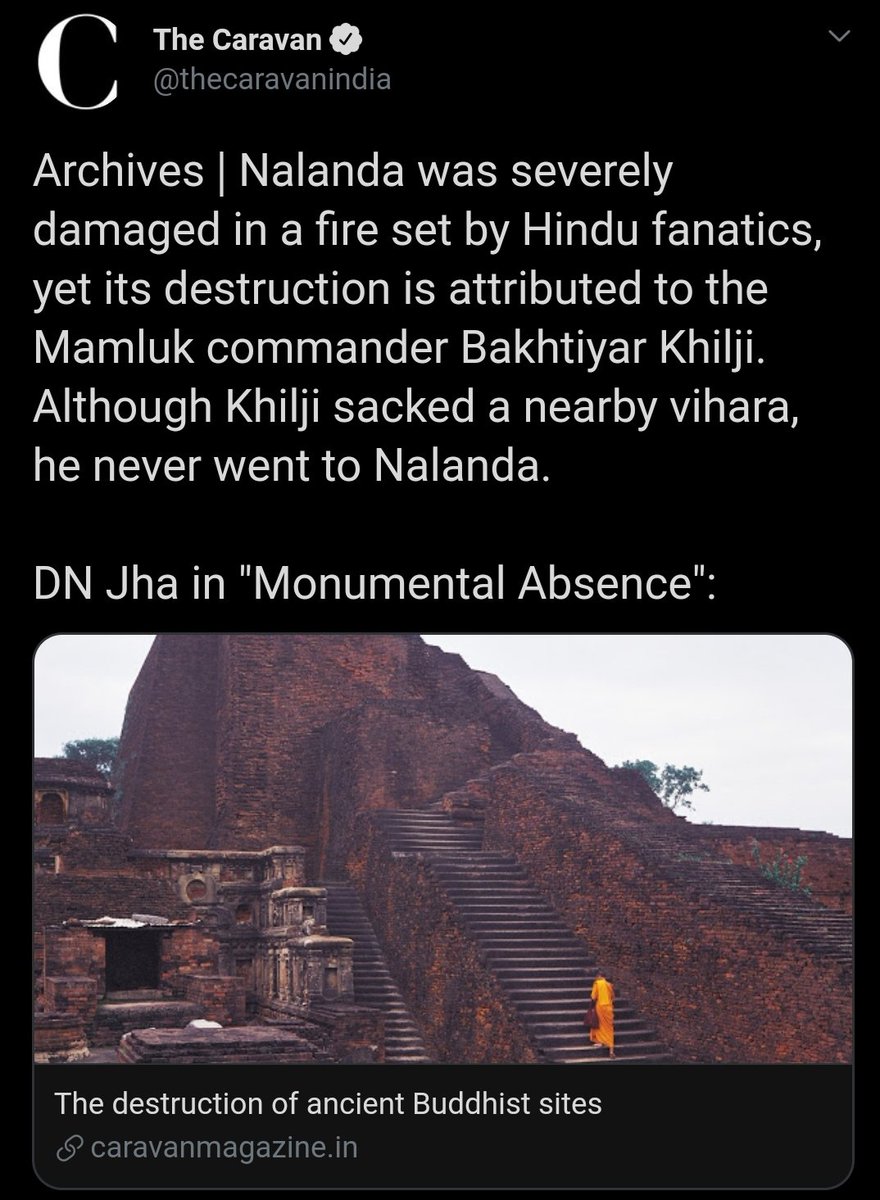
3. Prasar Bharati Chairman Dr. A. Surya Prakash said that Vinod K. Jose, Executive Editor of The Caravan magazine, made a “blatant” anti-India presentation during a session on ‘Religion and the Media’ at the Global Conference for Media Freedom, calling many of his statements “false” and “inaccurate”, report by The Hindu.
4. Christophe Jaffrelot and Leena Reghunath are regularly concerned about ‘Hindu terrorists’. They make unverifiable claims about the connection of the accused in the Malegaon blasts case with senior RSS and BJP leaders (September 2014).
5. Aileen Blainey goes to a Durga Vahini camp, which trains Hindu women in self-defense and calls that an exercise of Hindu patriarchy! (August 2013)
6. The Caravan unequivocally supports and promotes beef-eating. The Caravan’s promotion of beef-eating has been ongoing since its inception. Vinod K Jose in his article “The Beef Over Buff: Why Karnataka’s Cattle Slaughter Bill is Simply Ridiculous” (September 2010) posits the major tenets of The Caravan’s beef-promotion campaign.
7. The Caravan excels in Islamophilia. While it bashes each and every aspect of Hinduism, Hindu culture and society, it excuses the worst of the Islamic crimes and even manages to glorify them as ‘humanitarian initiatives’. Ferzina Banaji in her December 2010 article declares burqa as a secular revolutionary symbol! In a November 2014 article, madrassa education is justified on the basis that they linguistically empower the students.
On every single issue significant from the socio-cultural, political and religious point of view, The Caravan is a Hinduphobic magazine.
Read : Hinduphobia of The Caravan
Vishv Books of Delhi Press publishes anti-Hindu literature
1. Recently, a user on Twitter, who tweets under the username @kirron909, flagged off several titles Vishv Books had published that were off a markedly anti-Hinduism slant. Some of them were authored by Rakesh Nath, who is one of the inheritors of Delhi Press founded by Vishva Nath, and oversees the affairs of Vishv Books. Titles of the books include Dharmik Karmkand: Pando ka Chakravyuh and Dharm ka Shaap, which were authored by Rakesh Nath himself.
Numerous other books are apparently sold by Vishv Books on Amazon which seek to portray Hinduism in a negative light. Read More
2. An Amazon user has alleged that a seller-Vishv Books, Ghaziabad, Uttar Pradesh, has been fuelling anti-Hindu sentiments by sending a copy of a book “How irrelevant is Bhagwat Puran” marked as a “special gift” along with the ‘Shrimad Bhagwad Mahapuran’. The user has stated that the book packaged as “special gift” by the seller was a book written to denigrate the Bhagwad Puran and was meant to discourage the buyers from reading the Hindu holy book. The user had accused the bookseller of mocking the Hindu faith by unsolicitedly sending such a book that denigrates the Bhagwat Puran as ‘irrelevant’ and hurting the religious sentiments of the adherents. Read More
https://twitter.com/WarpedInGlory/status/1269859286982819842
Expanding the Reach of the Left
Of late, Delhi Press has embarked on expansion. It is constantly acquiring old magazines, reviving old ones and starting new publishing ventures. In the 21st century, this in itself raises doubts. This is a bad era for print magazines. Print readership is declining by the day. Many print magazines are shutting shop. And so, in such a dismal scenario, it is curious that Delhi Press is acquiring old magazines on the brink of collapse, like two Kannada language magazines, Nimmellara Manasa and Butti, or reviving the long defunct magazine like The Caravan., report by India Facts.
In this light, it does compel one to think of explanations like foreign funding coupled with ideological sponsorship, aimed at damaging the majority culture and society. Anyone who is familiar with Breaking India by Rajiv Malhotra would recognize such a threat.
Moreover, the recent acquisitions and talks of Delhi Press make no market sense. The company is not listed on the stock market. It does not sell shares as “it will then become answerable to shareholders and would have to generate profits.” The reason given behind this unwise market decision is that the “company values its independence.” Which does make sense from its perspective.
But the counter question arises: What is this ‘independence’ that Delhi Press is talking about? Is it ideological or merely principled journalism?
And even if one accepts the principled bit, how is it managing to keep the ship afloat in these dire times?
Wide Net
With millions and millions of readers, the Delhi Press has cast a rather wide net. From the elite English speaking crowd that is catered to by Caravan, to the Hindi speaking belt that is taken care of by Sarita. The Delhi Press has clearly not even spared the children with the regular propaganda spewed by Champak.
In the age of information warfare and perhaps, from a time that the information warfare as a formal concept was not even recognised in Indian media, The Delhi Press has chosen a side and has studiously stuck to it. The side does not stand for Hindus and evidently, nor does it stand for India.
Delhi Press is an anti-Hindu Group with powerful patrons who have vested interests to the detriment of Hindu society and culture.
Devdutt Pattanaik’s work : Distortions, Errors, Misrepresentations
Devdutt Pattkanaik is one of India’s bestselling authors on Hinduism today. He has a breezy, eay-to-read style, packaged for consumption by today’s urban Hindu who may have little time to delve deeper into his or her faith. His writings, however, have shown a persistent tendency to distort, misrepresent, and fabricate. His outbursts on social media paint a picture of a man driven by psychological problems, prone to hurling abuses when questioned and a remarkable inability to respond to valid criticisms.
Devdutt is an unabashed and self-proclaimed fan of Wendy Doniger. Wendy’s work on Hinduism has been shown to be marked by needless lies, omissions, and distortions that have been called out innumerable times by scholars, and yet which she has been unable to respond to. Her reputation as a scholar in the West continues to thrive, despite an unending stream of Hinduphobia that runs through her work on Hinduism and scholarly incompetence that would have ended most academic careers.
It is entirely possible that Devdutt is subconsciously paying homage to his idol by littering his work with the same kinds of errors and distortions that dog Doniger’s work. It is perhaps, in his mind, the ultimate act of submission, an intellectual prostration, of submission and self-degradation in an attempt to get the validation from a Hinduphobe.
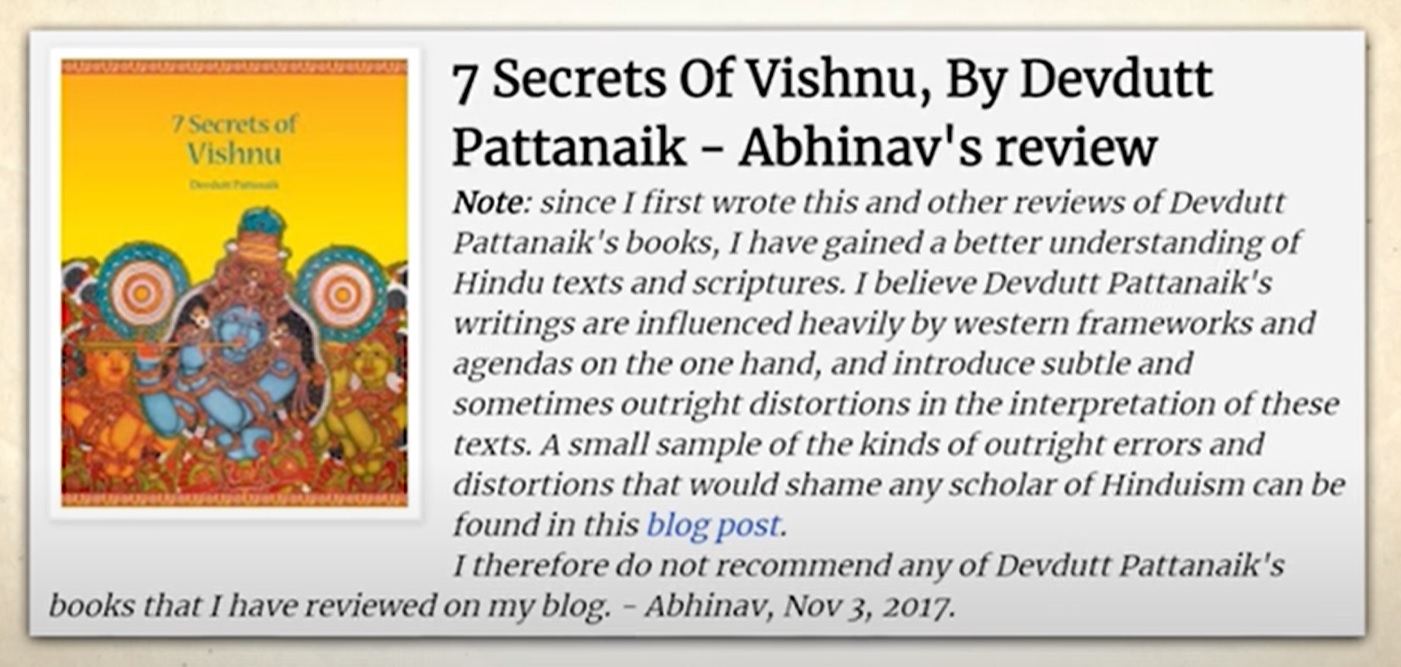
Innumerable errors, distortions, misrepresentations in Devdutt’s book “The Illustrated Mahabharata” – Report by Abhinav Agarwal
Nityananda Misra is an IIM graduate working in the financial industry. He is passionate about Hindu scriptures and has studied them out of interest. Nityanand has provided a detailed criticism of Devdutt Pattanaik’s works in a recent conversation with Rajiv Malhotra. The speaker reveals that the self-proclaimed mythologist’s writing is not based on stories in Hindu Puranas. He also reveals that the author might be misinterpreting Sanskrit words, report by OpIndia.
Nityanand claims that Devdutt has been inventing his own stories and selling them as Hindu mythology. In addition to this, Misra says that the Pattanaik has a special hatred for Brahmins and doesn’t accept genuine criticism of his work.
The full conversation can be watched below :
This is a detailed interview where he gives a point by point analysis of Pattanaik’s work. As summarised in the description of the video, Misra’s conversation with Rajiv Malhotra covers these topics
- Instances that indicate Devdutt does not know even the basics of Sanskrit.
- The mythologist’s obsession with looking for sexual meanings and his admiration for Wendy Doniger in the past.
- Pattanaik’s serious errors in translating very important Sanskrit words and gives them a completely distorted meaning.
- The self-proclaimed mythologist’s artificially inflated brand name that cannot be justified on merit.
Mr Misra has also written a detailed article criticising one of his most famous works ‘My Gita’. The book is a best seller and is being read widely in order to understand one of the most important Hindu scriptures. However, according to critics of Pattanaik, it contains serious errors.
It appears that Devdutt Pattanaik’s works are not indisputable and accurate interpretations of Hindu mythology and philosophy. By watering down its contents and misinterpreting them, Devdutt seems to be pursuing a certain politically motivated campaign to tilt his reader’s opinions towards a left-leaning ideology.
Nexus of ‘Dalit activists’ and Missionaries in India and the West
Many among those who pose as ‘Dalit activists’ in India are nothing more than public fronts of Christian missionaries who aim to slander the name of Hinduism with the ultimate goal of converting India to Christianity, report by IndiaFacts.
Many of these ‘intellectuals’ and ‘activists’ occupy influential positions in universities around the world. Ronald Radosh explains in Commies: A Journey Through the Old left, the New Left and the Leftover Left how the leftist conquest of the American universities was achieved in the 1960s and 70s. It tells the story of how the leftist professors, on the payroll of the Communist Party of the Soviet Union, gradually infiltrated the universities, occupying influential positions.
The non-leftist professors, who let them in, did not discriminate on the basis of ideology and readily accepted the leftists, even while rejecting their ideology. However, the leftists were not so forgiving. Just like Lenin destroyed all opposition, democratic or otherwise, once he grabbed power, these leftist professors hounded out the professors and students who dared to oppose their ideological stance. They created a patron-privilege system which ensured the hegemony of the Left in these universities and effectively blocked all non-leftist voices from the university campuses.
David Horowitz in 101 Professors explains how these leftist professors have aligned with political Islam and have turned American universities into hotbed of anti-Israel, anti-India, and pro-Islam activism. The process was replicated in almost all western countries, including Canada, where the Carleton University is located.
Chinnaiah Jangam is one of the breed: the leftist, Dalit activist, who is pro-Islam and pro-Christian and openly anti-Hindu and anti-India. He hides under the labels of ‘professor’, and ‘historian’, but is actually an anti-Hindu activist. He claims to be a ‘Dalit activist’, fighting for their rights, his affinity with Christian organizations is an open secret. He is a faculty member at Carleton University. A self-styled historian, most of his interests and activities are openly political. His research focus is the ‘engagement of Dalits with nationalism, colonialism, and above all Christianity’.
He is also a well-known rabble-rouser. His name surfaced during the California textbook controversy. Some anti-India activists and academicians proposed that the word ‘India’ should be replaced by the term ‘South Asia’ in the school textbooks. Many Indians rose to oppose this openly racist ruse against India’s right to self-determination. Vamsee Juluri, was one of the most prominent of the authors and professors who opposed this. Jangam, doing his duty, poured vitriol against him in articles published in publications such as Economic & Political Weekly.
His stated goal is to fight against Hinduism and show Dalit solidarity with Christianity. He is the foot soldier of the anti-Hindu leftist organizations which resort to intellectual terrorism by silencing the voice of their opponents. They are often successful in their designs and the Carleton University controversy is another such example.
Intellectual terrorism against Dr. Makarand Paranjape
The student wing of the Communist Party of India, organized an event in JNU in February 2016 against the hanging of the Islamic terrorist Afzal Guru, who was convicted for 2001 Indian Parliament attack. Many openly anti-Indian slogans were raised at the campus, including, “Bharat tere tukde honge, inshallah, inshallah” and “Afzal hum sharminda hain, tere kaatil jinda hain.” The ‘protestors’ directly threatened the Indian State, and its sovereignty, of breaking it up into many pieces. It was a clear case of aggression against the Indian State. Dr. Makarand Paranjape opposed the ‘protestors’, arguing that freedom of expression did not amount to open threats against Indian state.
That, as it appears, was his cardinal sin. Makarand Paranjape had dared defy the ultra-Left. A campaign of slander was built against him; a narrative of hate was carefully constructed aiming at silencing his rational voice. Here was a professor, who was reporting from the very campus of the JNU, and was exposing the leftist-Islamist nexus against the Indian state. He could not be allowed to spill the beans. He had to be silenced.
Dr. Paranjape faced vitriolic abuse by leftist ‘intellectuals’ in Indian newspapers, news channels and online mediums. He faced aggression and intimidation by the leftist students at the campus, when he was even barred from entering his own offices at the university campus.
Conclusion
The struggle for the control of the Hindu narrative has become uglier since 2012 when the possibility of Narendra Modi becoming the Prime Minister of India became a reality. The leftists feared their privileged positions; the anti-Hindu individuals and organizations in both India and abroad feared that their narrative might finally break down and the truth may come out, eventually paving out the way for the Hindus reclaiming their narrative.
Ever since he became India’s Prime Minister, leftist organizations all over the world sprang into action funding media houses, universities and political parties. They aroused fear and generated sympathy by parading Modi as the ultimate bogeyman ‘who aimed to destroy the secular fabric of India’. An unprecedented surge of Hinduphobic publications and incidents followed.
The anti-Hindu lobby managed and run by the leftists has sharpened the pitch of the battle in the western universities. In the coming times, more incidents of intellectual terrorism like the one involving Dr. Makarand Paranjape will be seen. More Hindu voices will be muffled by the leftists.
What Indians can do is to use whatever medium is available to them and rally around the victims of leftist intellectual terrorism. What they can do is to share these instances of intolerance as much as possible. What they can do is to make Indians as well as westerners aware of the truth so that one day the Hindus might regain the right of self-determination and get back the hold on the narrative of their own culture and civilization.
References:
Hinduphobia of The Caravan (India Facts)
Caravan 2.0: Why a Defunct Leftist Magazine was Revived (India Facts)
Anti-Hinduism as an Industry (India Facts)
Intellectual terrorism of the Left: The case for Dr. Makarand Paranjape (India Facts)
The Ideological Affiliations of The Caravan (India Facts)
Intellectual terrorism of the Left: The case for Dr. Makarand Paranjape (India Facts)

 Sign Petition: Stop the insult of Hindu Dharma by enacting an Anti-Blasphemy law !
Sign Petition: Stop the insult of Hindu Dharma by enacting an Anti-Blasphemy law ! HJS Impact : Malabar Gold replaces advt. after 'No Bindi No Business' backlash
HJS Impact : Malabar Gold replaces advt. after 'No Bindi No Business' backlash Propaganda against Hindu Festivals
Propaganda against Hindu Festivals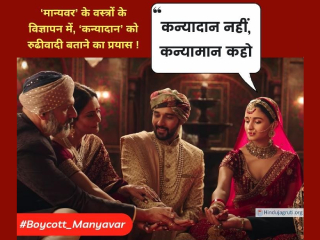 ‘Kanyadaan’ in Hindu Dharma is ‘Kanya-maan’ only; ‘Manyavar’ brand should render an apology to Hindus, else face boycott !
‘Kanyadaan’ in Hindu Dharma is ‘Kanya-maan’ only; ‘Manyavar’ brand should render an apology to Hindus, else face boycott !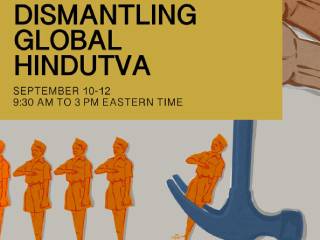 Sign petition asking universities to withdraw support to 'Dismantling Global Hindutva' event
Sign petition asking universities to withdraw support to 'Dismantling Global Hindutva' event Sign Petition : Facebook suspends Hindu Janajagruti Samiti’s Facebook pages without proper reason
Sign Petition : Facebook suspends Hindu Janajagruti Samiti’s Facebook pages without proper reason